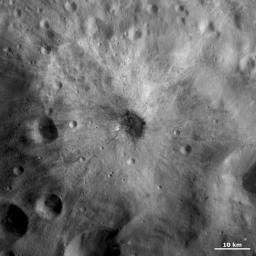Crater with Dark and Bright Ejecta
Caption:
This Dawn FC (framing camera) image is centered on a small, young, fresh crater with bright and dark ejecta rays extending from it. This image is a brightness image, which is taken directly through the clear filter of the FC, and shows the brightness and darkness of the surface. This crater is approximately 5km wide and its ejecta extends for up to 15 kilometers (9 miles). The ejecta rays outside of the crater are mostly bright. The dark ejecta rays mostly slump into the center of the crater, but there are some dark rays that extend for a few kilometers outside of the crater rim. This combination of bright and dark ejecta rays give the crater an impressively mottled appearance. There is dark and bright material located across Vesta but it is unusual to have a crater with both bright and dark ejecta rays.
These image is located in Vesta's Tuccia quadrangle and the center of the image is 26.6 degrees south latitude, 220.4 degrees east longitude. NASA's Dawn spacecraft obtained this image with its framing camera on Oct. 22, 2011. This image was taken through the camera's clear filter. The distance to the surface of Vesta is 700 kilometers (435 miles) and the image has a resolution of about 70 meters (230 feet) per pixel. This image was acquired during the HAMO (high-altitude mapping orbit) phase of the mission.
Background Info:
The Dawn mission to Vesta and Ceres is managed by NASA's Jet Propulsion Laboratory, a division of the California Institute of Technology in Pasadena, for NASA's Science Mission Directorate, Washington. UCLA is responsible for overall Dawn mission science. The Dawn framing cameras have been developed and built under the leadership of the Max Planck Institute for Solar System Research, Katlenburg-Lindau, Germany, with significant contributions by DLR German Aerospace Center, Institute of Planetary Research, Berlin, and in coordination with the Institute of Computer and Communication Network Engineering, Braunschweig. The framing camera project is funded by the Max Planck Society, DLR, and NASA/JPL.
More information about the Dawn mission is online at
http://www.nasa.gov/dawn
and
http://dawn.jpl.nasa.gov
.
Cataloging Keywords:
| Name |
Value |
Additional Values |
| Target |
4 Vesta |
|
| System |
Main Belt |
|
| Target Type |
Asteroid |
|
| Mission |
Dawn |
|
| Instrument Host |
Dawn |
|
| Host Type |
Orbiter |
|
| Instrument |
Framing Camera (FC) |
|
| Detector |
|
|
| Extra Keywords |
Crater, Grayscale |
| Acquisition Date |
|
| Release Date |
2012-01-26 |
| Date in Caption |
2011-10-22 |
|
| Image Credit |
NASA/JPL-Caltech/UCLA/MPS/DLR/IDA |
| Source |
photojournal.jpl.nasa.gov/catalog/PIA15323 |
| Identifier |
PIA15323 |

 Planetary Data System
Planetary Data System
